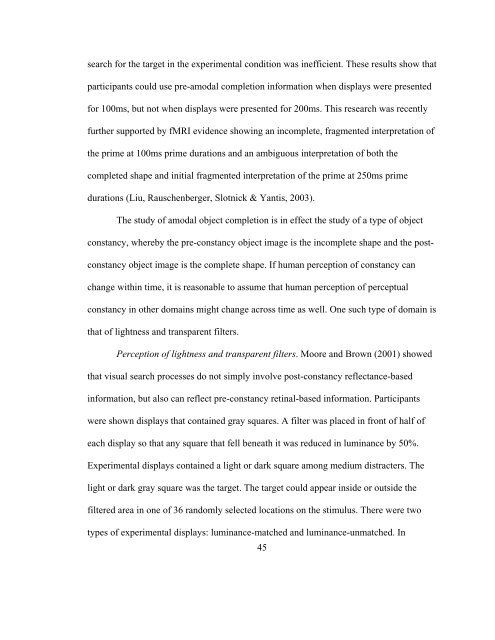The Use of Iambic Pentameter in the
The Use of Iambic Pentameter in the
The Use of Iambic Pentameter in the
Create successful ePaper yourself
Turn your PDF publications into a flip-book with our unique Google optimized e-Paper software.
search for <strong>the</strong> target <strong>in</strong> <strong>the</strong> experimental condition was <strong>in</strong>efficient. <strong>The</strong>se results show that<br />
participants could use pre-amodal completion <strong>in</strong>formation when displays were presented<br />
for 100ms, but not when displays were presented for 200ms. This research was recently<br />
fur<strong>the</strong>r supported by fMRI evidence show<strong>in</strong>g an <strong>in</strong>complete, fragmented <strong>in</strong>terpretation <strong>of</strong><br />
<strong>the</strong> prime at 100ms prime durations and an ambiguous <strong>in</strong>terpretation <strong>of</strong> both <strong>the</strong><br />
completed shape and <strong>in</strong>itial fragmented <strong>in</strong>terpretation <strong>of</strong> <strong>the</strong> prime at 250ms prime<br />
durations (Liu, Rauschenberger, Slotnick & Yantis, 2003).<br />
<strong>The</strong> study <strong>of</strong> amodal object completion is <strong>in</strong> effect <strong>the</strong> study <strong>of</strong> a type <strong>of</strong> object<br />
constancy, whereby <strong>the</strong> pre-constancy object image is <strong>the</strong> <strong>in</strong>complete shape and <strong>the</strong> post-<br />
constancy object image is <strong>the</strong> complete shape. If human perception <strong>of</strong> constancy can<br />
change with<strong>in</strong> time, it is reasonable to assume that human perception <strong>of</strong> perceptual<br />
constancy <strong>in</strong> o<strong>the</strong>r doma<strong>in</strong>s might change across time as well. One such type <strong>of</strong> doma<strong>in</strong> is<br />
that <strong>of</strong> lightness and transparent filters.<br />
Perception <strong>of</strong> lightness and transparent filters. Moore and Brown (2001) showed<br />
that visual search processes do not simply <strong>in</strong>volve post-constancy reflectance-based<br />
<strong>in</strong>formation, but also can reflect pre-constancy ret<strong>in</strong>al-based <strong>in</strong>formation. Participants<br />
were shown displays that conta<strong>in</strong>ed gray squares. A filter was placed <strong>in</strong> front <strong>of</strong> half <strong>of</strong><br />
each display so that any square that fell beneath it was reduced <strong>in</strong> lum<strong>in</strong>ance by 50%.<br />
Experimental displays conta<strong>in</strong>ed a light or dark square among medium distracters. <strong>The</strong><br />
light or dark gray square was <strong>the</strong> target. <strong>The</strong> target could appear <strong>in</strong>side or outside <strong>the</strong><br />
filtered area <strong>in</strong> one <strong>of</strong> 36 randomly selected locations on <strong>the</strong> stimulus. <strong>The</strong>re were two<br />
types <strong>of</strong> experimental displays: lum<strong>in</strong>ance-matched and lum<strong>in</strong>ance-unmatched. In<br />
45

















